Emeodilichi H. Mba
Department of Geography, Nasarawa State University, Keffi, Nigeria
Correspondence to: Emeodilichi H. Mba, Department of Geography, Nasarawa State University, Keffi, Nigeria.
| Email: |  |
Copyright © 2018 The Author(s). Published by Scientific & Academic Publishing.
This work is licensed under the Creative Commons Attribution International License (CC BY).
http://creativecommons.org/licenses/by/4.0/

Abstract
Challenges posed by constant deforestation with no reforestation programs and policies are high, constraints impose by lack of proper awareness, inability of government to provide basic amenities and lack of proper environmental protection law to be enforced. Many are still in extreme poverty with inequality of income rising so high to the point of no more middle class, combined with rapid increase in population, domestic weakness drive from social-economic and political structure, bad government, poor Urban planning and poor access to the basic services such as electricity, kerosene and cooking gas, lack of reforestation awareness, all this contributes joined with high rate of tree cutting for domestic use such as fire-wood and charcoal production. Charcoal production is considered to be one of the major contributing factors to deforestation in the country followed by desertification and Urbanization which the later is the main contributor of deforestation in Enugu state. This paper recommends that government should create public awareness, monitoring and laws with provision of basic amenities that will substitute charcoal and fire-woods that is predominantly used by high percentage of middle and lower class in the country with proper urban planning.
Keywords:
Deforestation, Environmental Degradation, Reforestation
Cite this paper: Emeodilichi H. Mba, Assessment of Environmental Impact of Deforestation in Enugu, Nigeria, Resources and Environment, Vol. 8 No. 4, 2018, pp. 207-215. doi: 10.5923/j.re.20180804.03.
1. Introduction
Deforestation is the process of clearing, removal of forest trees where the land is converted to other types of activities for non-forest use, like conversion of forest reserves areas to residential or industrial areas, removing of forest trees as a result of road or rail construction, conversion for agricultural purposes and cutting down of forest trees for domestics and industrial use like fire-woods, timbers, paper production and charcoal production. Charcoal is widely used by high percentage of the population in the country for cooking and other uses, that’s what makes it a major threat to forest reserves. About 31% of the world land surface is covered by forest, while in Nigeria it falls gradually from 16.6% in 1996 to 7.7% in 2015. According to Michael Daley, associate professor of environmental science at Lasell College in Newton, Massachusetts, the number one major problem caused by deforestation is the impact on the global carbon cycle. Gas molecules that absorb thermal infrared radiation are called greenhouse gases. If greenhouse gases are in large enough quantity, they can force climate change, according to Daley deforestation of trees not only lessens the amount of carbon stored, it also releases carbon dioxide into the air. This is because when trees die, they release the stored carbon. High percentage of people are not aware of all this impact, not that they don’t feel the it but they are not being informed about it and that’s main reason awareness, environmental law and monitoring is very important so that it will help to regulate the rate of unplanned deforestation, to restore and rehabilitate degraded forest landscape and evaluate the important of carbon sequestration by forest.Deforestation has resulted in habitat damage, biodiversity loss and aridity, as a developing nation a lot of development are been taking place in daily basis like roads, rails, houses, dams and oil explorations, most of all this falls into urbanization that contributes to deforestation process due to lack of proper reforestation planning that should had be going on simultaneously with all this developments. Poverty contributes its own percentage due to lack of some basic amenities that results in people looking for means of survival and lack of proper awareness and enforcement of government policies that will guide public's of the risk of deforestation for domestic activities without reforesting. According to the 2010 Global Forest Resource Assessment, deforestation releases nearly a billion tons of carbon into the atmosphere per year, though the numbers are not as high as the ones recorded in the previous decade. This carbon released causes climate change which creates severe weather conditions like droughts, floods and hot weather conditions. According to Food and Agricultural Organization of United Nation as of 2005 Nigeria has highest deforestation rate in the world at 12.2% equivalent of 11,089,000 hectares had been deforested and between (2000 to 2005), 55.7% of our primary forest was been lost and the rate of forest change increased by 31.2% to 3.12% per annum, which is approximately 350,000 to 400,000 hectares per year. Nigeria lost an average of 409,700 hectares of forest every year which is equal to annual deforestation rate of 2.38%. According to Mfon et al (2014) Nigeria has eight National parks; of the entire eight and damages inflicted to these parks as results of human and natural factors are tremendous and it will keep on increasing everyday if not properly addressed. This human and natural factors like, global warming, insurgency, desert encroachment, over grazing and other agricultural activities.Table 1. Number of Major National parks in Nigeria
 |
| |
|
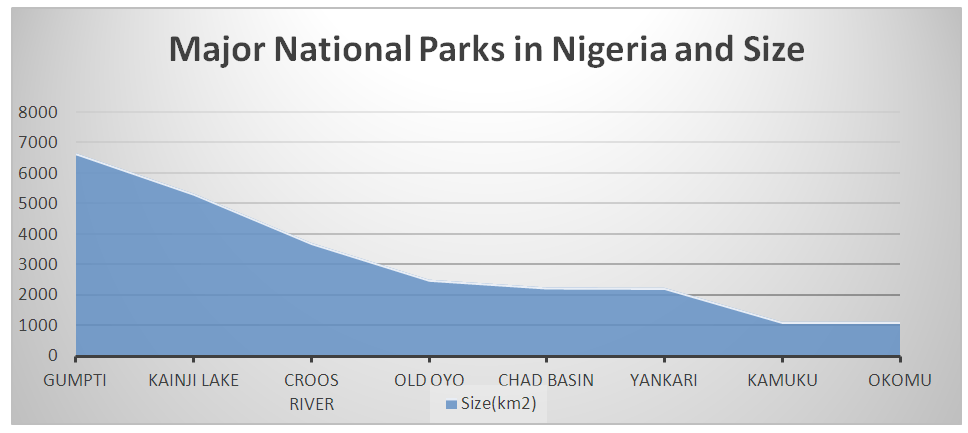 | Figure 1 |
Major causes of deforestation in Nigeria are; i. Desertification.ii. Poverty.iii. Urbanization.iv. Fuel Wood production.Desertification: Desertification is the process desert encroaches into a land that is once fertile. This situation mostly happens in some northern states of Nigeria which are under serious threat of desertification like; Adamawa, Bauchi, Borno, Gombe, Taraba, Sokoto and Yobe States that are all prom zone for desertification. A study conducted 1901 to 2005 shows that Nigeria had temperature increase of 1.1C of the global mean temperature increase of 0.74C. Combination of high rate of deforestation with no reforestation plans increases the temperature which reduces the amount of rainfall year in and out, contributes highly to the desertification of the country, for study shows that Carbon emission from deforestation accounts for 87% of total carbon emission of the country.Poverty: High rate of poverty in the country contributes connects much to deforestation, reason because 95% of the population depends on kerosene which is not cheap to get due to cost, as a result of it, high numbers depends on wood fuel widely known as Charcoal in the country for their live hood for people in the rural areas and urban areas with its modern constructed charcoal burners. With the high demands of this product called charcoal which is been produced through cutting down of forest trees comes high rate of deforestation, also another source of income for many people. This charcoal production has severe effects to our forest reserves.Table 2. Poverty Rate Per Capita in Nigeria by Zones
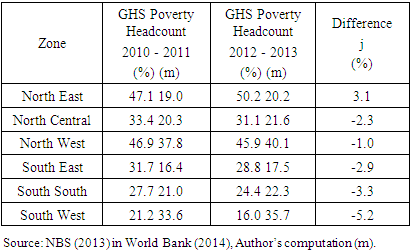 |
| |
|
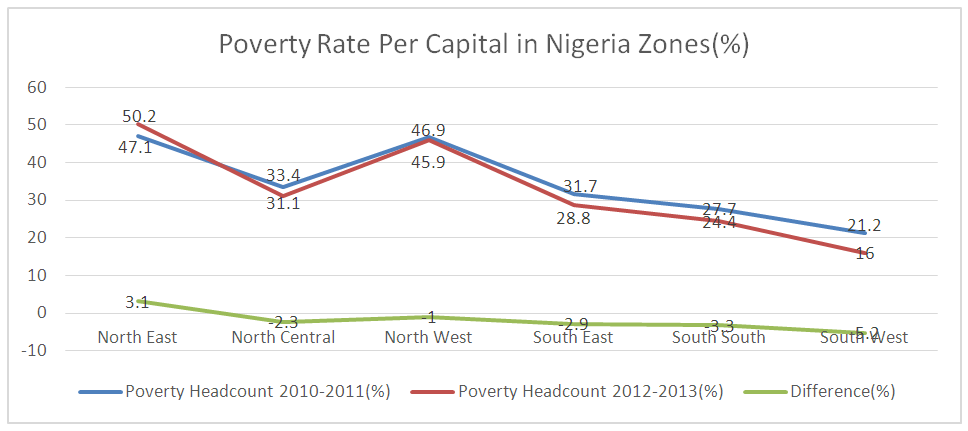 | Figure 2 |
Note: GHS = General Household Survey. m = Population in millions. West and South-South, a remarkable reduction in the number of people living under poverty has been recorded, with 5.3% and 3.3%, respectively.From table 2, shows high rate of poverty which results in deforestation like tree cutting for fuel wood (charcoal) production. According to Hyde (2004) who stated that forests and poverty go hand in hand, and where one is found, there is often the other.Urbanization: This is a process that leads large number of people to become permanently concentrated in a relatively small area that goes with more construction of settlement which will result in conversion of forest reserves to residential and agricultural purposes. This current state of the environment is been allowed by State Department of forestry which have not implemented any forestry management policies to reduce deforestation since 1970s. No conservation effort, Public awareness education, for people to know there role, advantage and threat it poses to the natural resources, environment and its health effect, that will add as a catalyst for them to engage in massive reforestation project just like Japan did (McKean 1982, 1986) which made them to start planting sugi and hinuki. Wood Fuel Production: Wood fuel are those various forms of wood that are used as fuel for cooking, heating and to drive stem-power engines or turbines such as firewood, charcoal, chip, sheet, pallet and sawdust. The use of wood for a fuel source is older than recorded in history is believed to be main innovation that allowed for development of civilization. Over consumption of this wood fuel has led to deforestation and habitat loss with its combustion that generates emission impact to the climate change.Table 3 and Figure 3 findings reflect on huge continuous production and consumption of wood fuel in the country from 1997 to 2016. Hyde (2004) who stated that forests and poverty go hand in hand, and where one is found, there is often the other. From the table 3 below it indicates that within this short period of time Industrial consumption accounted for only 20.38% while the remaining 79.62% is all for domestics consumption.Table 3. Wood Fuel consumption in Nigeria from (1997 – 2006; 000m3)
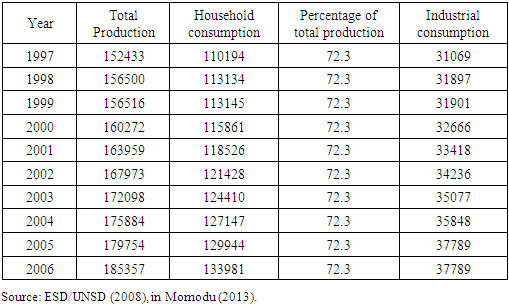 |
| |
|
 | Figure 3 |
It indicates high dependence of forest resources for livelihood by very large population of the country places the forest reserves at the risk and some tree species going extinct. Na’ibbi and Heady (2013), Akwa (2013) and Ibe (2014) all affirmed that in spite of the fact that income, prices of fuel wood and its substitutes are major determinants of the consumption of fuel wood, there was uniformity in reporting that the larger population are still mainly relying on this source of energy for most of their domestic uses. Deforestation leads to environmental degradation which is disintegration of earth or deterioration of the environment by the action of humans none or unknown through depletion of resources such as air, water and soil. It can also be refer as destruction of habitat and the ecosystem, extinction of wildlife, which also generates pollution and some form of natural disaster like gully erosion which all falls to the impacts of deforestation.Deforestation impacts are; i. Environmental impacts ii. Social impactsiii. Health impact iv. Economic Impact.Environmental impacts: Environmental impacts result in loss of bio-diversity, endangering of plants and animals which is been caused by constant deforestation of forest reserves meant for the purpose of protecting immediate environment and serve as shield direct impact of downpour of rain, high temperature and wind that will result of erosion, flood and other environmental instability. For example highland vegetation of south eastern part of the country was rich thick forest but due to the massive deforestation caused by urbanization, increase in population created gully erosion problems, which could had been prevented through reforestation process to prevent downpours from washing away natural habitats.Social impact: Social impact occurs at the result of high rate of deforestation which cause degradation to the environment and forced the local dwellers to move into the urban areas which result to over population and lack of jobs, increase on crime rate and lack of social amenities to take care of the population. Example Deforestation in Anambra that has resulted into heavy gully erosion that have relocated some villages from their home, Oil exploration in the Niger Delta which have forced many villages out of there place as the result of degradation of their land. Results of this forced people out of their home which they have means of live hood to move to the urban area with no hope of job or source of income.Health impact: Health Impact occurs when the greater population of the people have migrated to the urban areas due to degradation in their rural areas caused by crisis, deforestation, oil spills, and erosion with less infrastructures in the urban centers, lack of basic amenities like water and electricity, lack of proper drainage system which will result in outbreak of diseases mostly malaria, Lassa fever and other diseases. Example Abakpa Nike an already densely populated area with poor urban planning which more people form Ugwuogo Nike moves to the area due to deforestation caused by wood fuel and urbanization process going on in there forest reserves. Economic impacts: Economic Impacts has also effected the environment negatively especially in the Niger Delta where oil exploration is been taking place, as petroleum and gas sector covers over 97% of the country GDP, there is an increase in oil exploitation which keeps increasing degradation on the environment like Ogoni Oil spills that have brought a lot of damages to the ecosystem within that environment.
2. Materials and Methodology
This study was conducted in Enugu state of Nigeria, it is located in the South-Eastern part of the country and it shares boundaries with 5 other states like Anambra, Abia, Ebonyi, Kogi and Benue state. Major contribution to deforestation in this area is urbanization and industrial development which is been caused by high population increase. This impact of high population increase and economics growth has endangered the forest reserves in the state. Ministry of environment and solid minerals which houses the state forestry commission has four major forestry zones, Enugu, Awgu, Orji River and Nsukka which comprises developed, undeveloped or abandoned forest reserves like; Enugu, Enugu-water, Enugu-extension, Akpakume-nze, Agu-obu Owa, Miliken Hill, Oji-River, Awlaw-Isikwe Achi, IfiteAmoli, Akwari Ani and Mammu-River forest reserves. Table 4. Forest Reserve, Location and Areas covered in Enugu State
 |
| |
|
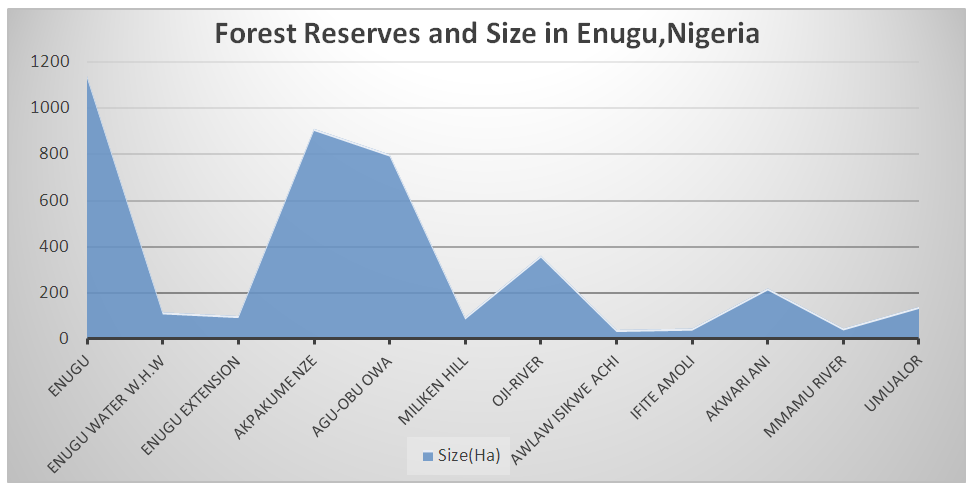 | Figure 4 |
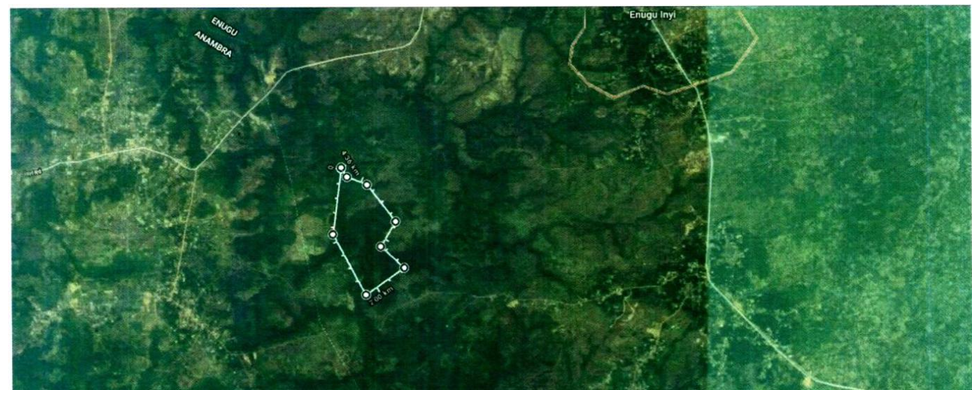 | Figure 5 |
Mammu - River Reserve Aerial view marked, (Total area: 8889,010.53m2)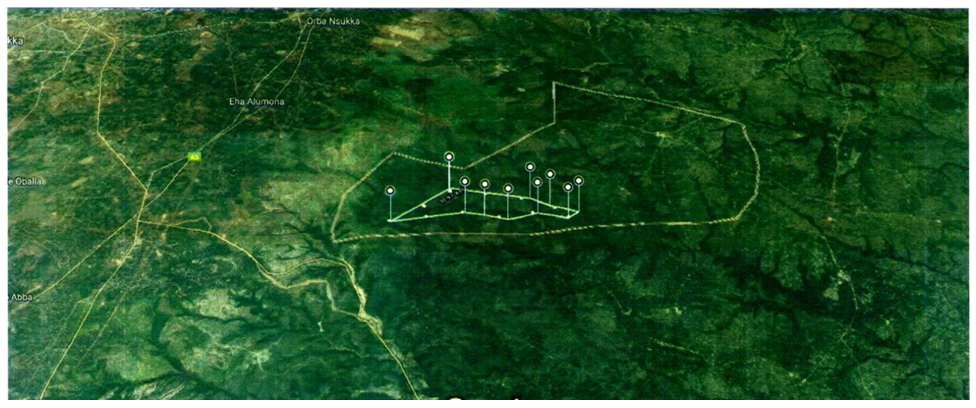 | Figure 6 |
Akwari Reserve Aerial view marked, (Total area: 2.98 km2)This paper is based on primary and secondary source, interviews, discussions with Enugu state forestry commission, forest guards and information’s accessed through review of relevant texts, interviews, discussions, journals, newspapers, official publications, magazines and internet which served as tangible source of insight into deforestation and its effects to the environment.Data collected from both forest reserves (Mmamu and Akwari) where on indication of deforestation, the two criteria and indicator associate developed for Nigeria context by Ebo (2000) which was used to check status of deforestation of forest reserve caused by Urbanization, Agricultural and poor policies and monitoring. Both forest reserves generate highest and lowest income revenues respectively.Table 5. Criteria and Indication (C&I) Framework
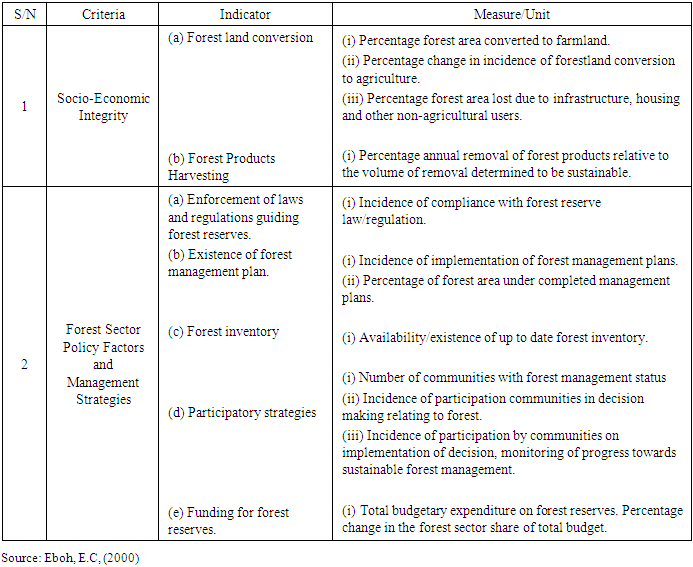 |
| |
|
3. Results and Discussion
Mammu-River reserve covers total land area of 46.80ha and 61% which is 28.548ha are area left covered, while since 1927 an estimation of 11.975ha of trees has been lost.Akwari reserve area covered area predominantly by cashew trees is 134.2ha and since 1974 the forest reserve covers over 220ha with estimation loss of 3.597ha per annum.Forest rangers agreed and some disagreed that high access to farmland within this forest contributed to its high depletion, 80% of forest rangers agreed while 20% disagreed on the impact of high access to farmland and believe is low.Mmamu-River reserve forest alone total of 30% which is 14.04ha of the reserve is been converted to farmland, with this 30% conversion mostly happens annually in maximum basis in the forest.Table 6. Mmamu River forest reserve depletion factors and rate (%)
 |
| |
|
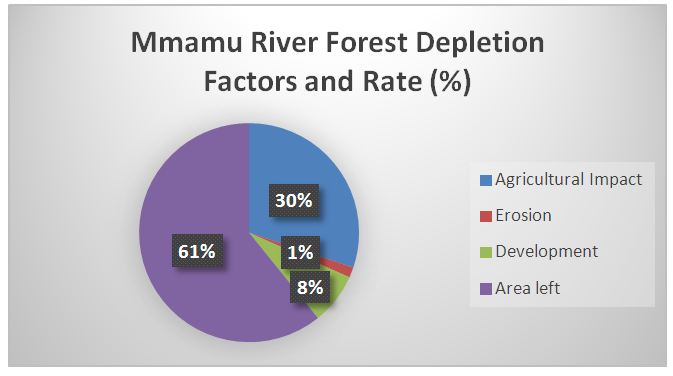 | Figure 7 |
While over 24% of Akwari forest reserves is been depleted through domestic activities like wood fuel productio, other factors like Agricultural activities, infrastructural development and erosion contributes some parts.Table 7. Akwari Forest depletion factors and rate (%)
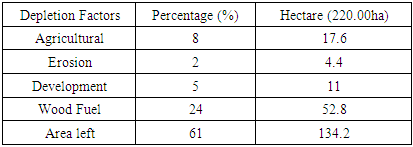 |
| |
|
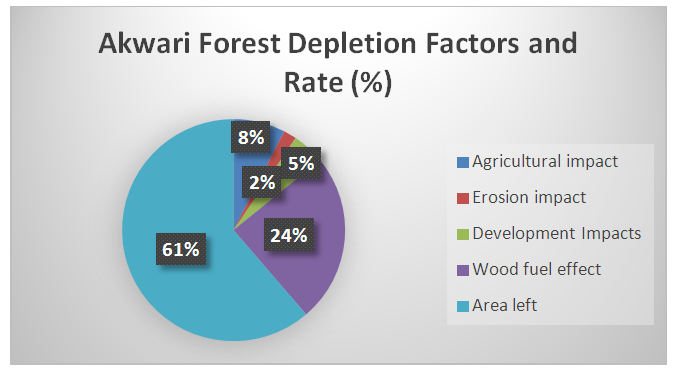 | Figure 8 |
Akwari reserve experience minimum impact of agricultural activities and high impact domestic activities like wood fuel production.Other factors contributing to deforestation in this two forest reserves mentioned are;i. Lack of law enforcement ii. Lack of afforestation programiii. Poor awareness iv. Poor fundingLack of law enforcement: According to the ministry of forestry, poor manpower contributes highly to this situation, inadequate funding which effects logistics for the rangers movement.Lack of Afforestation program: Both forest reserves has no afforestation program, according to the rangers some programs only ends up in paper with no implementation process so they only depends on natural regeneration of trees.Poor Awareness: Most villages around this reserves has no knowledge of effects of deforestation, of over 35 individual only 3 has like 60% knowledge of deforestation effects which is like 80% knows nothing about it and ministry with the rangers don’t carry them along, no public participation so they will know some ways in which they can also contribute to the problem. Poor Funding: Ministry of forestry has the lowest budget in the state, which comes down to that lack of manpower and logistic, recruitment of new rangers never take place for a while and even the once working there are ill equipped for the job, only there for the monthly pays.With all this data and report if the situation is not been addressed within 11 to 12years most forest reserves will be lost to deforestation effects and once that will remain will be highly depleted.
4. Recommendations and Conclusions
Solution to deforestation challenges in Nigeria policy and resilience, careful choice of priorities, prudent forest management and getting involve the private sectors, combined with proactive actions and policies. Nigeria leaders current and future should prioritize educating the young generations’ dangers posed by this maniac going on in all the major forest reserves. The poor are most vulnerable to environmental hazards and owing to unequal distribution of assets in the country, will also suffer most from the effects generated by deforestation. Increase in temperature, Erosion, Flood, and other forms of degradation effects. Increasing the opportunity for the vulnerable is the only way to sustain overall growth and reduce disparity. Disparity on basic amenities like kerosene, cooking gas and electricity most be reduced drastically so the even if the laws is been enforced, poor people will have alternatives and see reason to keep to the rules and regulations.Public should focus more in creating enabling environment by engaging on tree planting not only in the forest but within our environs while government should be to facilitate, support and make those basic amenities easy to access also leverage the strength of the stakeholders to create policies with significant outreach at maximum efficient with less burden on the public resources. Contribution of the public sector, NGO, global partnerships, research and academics communities discovering the best species of trees forest for each region of the country and also normal settlements. Poor population itself are essential with proper awareness and education. Monitoring on kerosene been supplied to the public's to avoid adulterated products which most time causes fire outbreak at home that also discourage some household from using kerosene. Re-using of papers and plastic bags to discourage deforestation.Nigeria have good enabling environment for forestry but need to expend in scope, coverage, efficient to sufficiently serve other some regions that had been disadvantaged by heavy deforestation and environmental degradation that had been happening on their environs. Government will benefit in pursue a well-articulated forestry policies programs significantly reducing the burden on the major towns and cities; also improve in the supply of affordable basic amenities thereby making life unproblematic to the citizenry.
References
| [1] | Omofonmwan, S. I., and G. I. Osa-Edoh. "The Challenges of Environmental Problems in Nigeria." Journal of Human Ecology 23.1 (2008): 53-57. |
| [2] | Gerry Marten ''Environmental Tipping Points: A New Paradigm for Restoring Ecological Security’’ Journal of Policy Studies (Japan), No.20 (July 2005). |
| [3] | Ishmeal Ogboru and Rosemary Anga “Environmental degradation and sustainable economic development in Nigeria’’ journal of economics 2015. |
| [4] | SAFnet Dictionary Definition For [deforestation]. Dictionary of forestry.org (29 July 2008). Retrieved 2011-05-15. |
| [5] | Odjugo, Peter A. "General Overview of Climate Change Impacts in Nigeria." Journal of Human Ecology 29.1 (2010): 47-55. EBSCO. |
| [6] | Akinbami, J. "An Integrated Strategy for Sustainable Forest–energy–environment Interactions in Nigeria." Journal of Environmental Management 69.2 (2003): 115-28. Science. |
| [7] | Johnson, D.L., S.H. Ambrose, T.J. Bassett, M.L. Bowen, D.E. Crummey, J.S. Isaacson, D.N. Johnson, P. Lamb, M. Saul, and A.E. Winter-Nelson. 1997. Meanings of environmental terms. Journal of Environmental Quality 26: 581–589. |
| [8] | Muhammad Rabi’u Ja’Afar-Furo “Dynamics of poverty, deforestation and beekeeping in Northern Nigeria, concern for policy makers –part II” Journal of physical and Agricultural science. 2016. |
| [9] | Ogundele Adeola Tunde Oladipo Micheal O, Adebisi Olusegun Mathew “Deforastation in Nigeria: The need for urgent mitigation measures” Journal for Geography and Environmental Management, 2016. |
| [10] | Ebe F.E “Socio-economic factor influencing the use of fuelwood in urban area of Enugu state, Nigeria” Journal of business and management, 2014. |
| [11] | Rainforest analysis at Mongabay.com. |
| [12] | Conserve-energy-future-facts. |
| [13] | "The Double Edge of Globalization". Yale Global Online. Yale University Press. June 2007. |
| [14] | Intergovernmental Panel on Climate Change (2000). Land Use, Land Use Change and Forestry. Cambridge University Press. |











 Abstract
Abstract Reference
Reference Full-Text PDF
Full-Text PDF Full-text HTML
Full-text HTML





